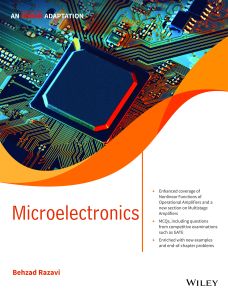Microelectronics, 3ed, An Indian Adaptation
ISBN: 9789388991063
804 pages
Publication Year: 2020
For more information write to us at: acadmktg@wiley.com

Description
Microelectronics provides a comprehensive discourse on the theory and applications of analog electronic circuits. Starting with the basic physics of semiconductors, the book goes on to discuss diodes, bipolar and MOS transistors, rectifier and amplifier circuits, sinusoidal and nonsinusoidal oscillators, frequency response of amplifiers, and finally analog filters. The book incorporates a host of pedagogical features that make the book easy to teach and learn from, including application sidebars, self-check problems with answers, and simulation problems with SPICE.

